Gigabyte's Core i5 Contenders: P55-UD4P And P55-UD6
A Trend Toward 2 Ounces
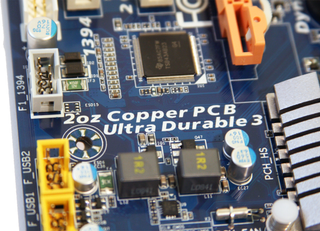
As mentioned, the P55-UD6 is another Ultra Durable 3-based design with Gigabyte's touted two ounce copper power and ground motherboard layers (the -UD6 is an eight-layer PCB). We've had a hard time quantifying the benefit of this addition in the past, since the benefits are said to be lower temperatures thanks to lower impedance, but perhaps the greatest evidence that there's some meat behind the marketing is the fact that Asus is also onboard the two ounce copper train (and indeed implemented this on an older workstation board).
More Power Circuitry

A complex 24-phase VRM means that there isn't enough room on the top of the motherboard for all of the circuitry. A slew of MOSFETs and Intersil phase doublers constitute the backbone of Gigabyte's solution, generating 24 phases with 12 PWM inputs. It is, perhaps, notable that the VRM circuitry on the bottom of the board isn't cooled by an elaborate heat sink/pipe, suggesting that expensive power circuitry cooling is likely over-the-top for most Core i5-based platforms.
Eagerly Awaiting P55-UD6
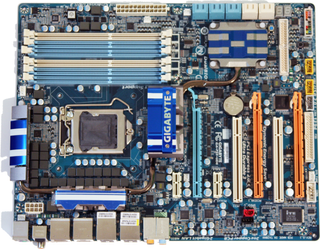
Gigabyte employs a familiar layout, but not one we've yet seen from a P55-based platform. Asus and Gigabyte drop the single-chip chipset behind the expansion slots on their less-expensive offerings. However, because Gigabyte's original plan accounted for three SATA controllers down there, the -UD6 features its P55 right where you would have expected to find an X58 or P45 northbridge.
A heatpipe connects the P55's passive cooler to what appears to be a southbridge heatsink. But because the two Marvell 6 Gb/s SATA controllers were scrapped, there's a fair chance that this board's cooling solution will change before it ships.
P55 Goes Value-Oriented

Taking a step down Gigabyte's P55 family results in a completely different board design, but a functionally-similar offering--great news for the value-oriented folks who'd like to save some money, but still buy a solid motherboard.
Let's take a look at Gigabyte's P55-UD4P. First, though: what differentiates the -UD4P from the planned -UD4 model? As far as we can tell from the proposed specs, the -UD4P has a Trusted Platform Module, whereas the -UD4 does not. That seems to be it, though.
Back To Basics: The P55-UD4P
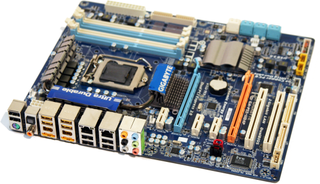
Put side-by-side with the EP55-UD6, the -UD4P looks quite a bit different. But the two boards actually share a lot of core functionality in common.
Stay on the Cutting Edge
Join the experts who read Tom's Hardware for the inside track on enthusiast PC tech news — and have for over 25 years. We'll send breaking news and in-depth reviews of CPUs, GPUs, AI, maker hardware and more straight to your inbox.
Still Lots Of Rear IO
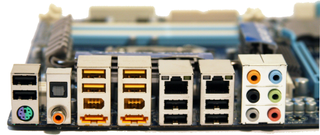
The similarities are apparent beginning with the rear I/O panel. This time, however, you get 10 USB 2.0 ports back there, the same single PS/2 port, two digital audio connectors (optical and coaxial), a pair of FireWire ports, two eSATA connectors, twin 8P8C jacks, and a full complement of 1/8" mini-jacks.
Enough Expandability For Almost Anyone
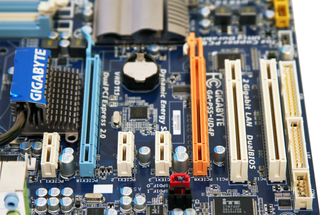
Gone is the third PCI Express x16 slot. Instead, the P55-UD4P includes two x16 slots (which run at x8 signaling rates when you're using a pair of cards in either SLI or CrossFire), two standard PCI slots, and a trio of x1 PCIe slots.
There are no worries about outstripping the chipset's PCI Express capabilities on this one. Between the three x1 slots, a Marvell storage controller, a JMicron storage controller, and two Gigabit Ethernet controllers, the P55-UD4P utilizes six of the P55's eight available links.
Still An Engineering Sample
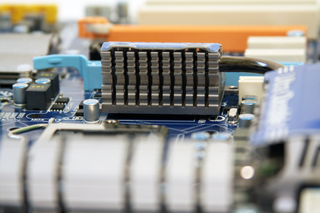
Perhaps you looked at that three-quarter shot a few pages back and wondered why the P55-UD4P had a passive heatsink layout similar to the -UD6. Proof that these boards are still early samples, the sink covering the area where you'd normally expect to find a northbridge isn't actually covering anything. Rather, the P55 PCH sits behind the board's expansion slots.
Gigabit Ethernet
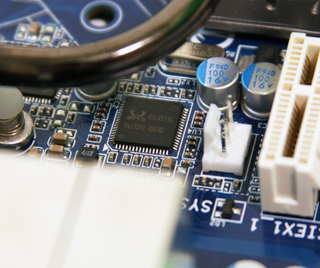
Like the P55-UD6, this motherboard boasts a pair of Gigabit Ethernet controllers. Gigabyte's official spec sheet says the final board will include two Realtek 8111D controllers, which support jumbo frames. But the early sample we shot here is still rocking the 8111Cs.
High Def Audio
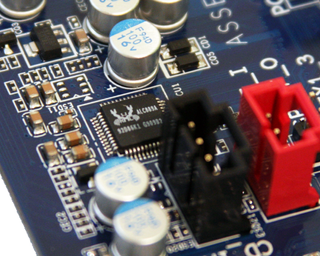
It's hardly a surprise to find Realtek's ALC889 High Definition Audio codec onboard. But we did think it was worth noting that this codec specifically is one only two able to output two channels of 192 kHz/24-bit or 4-8 channels of 96 kHz/24-bit audio when used in conjunction with Cyberlink's PowerDVD 9.
-
mlcloud Pity that it's gonna be hard to get anything stronger than 2x 4870s on these machines.Reply -
cangelini I was running them with a pair of 4870 X2s without a problem. Though I can't publish numbers yet, you'd be surprised how close comparably-clocked i7 and i5-based machines will come.Reply -
paohyean I think the eSATA ports at the back panel are the eSATA/USB combo ports as there are only 2 more headers for 4 front USB ports...Reply
=) -
JeanLuc cangeliniI was running them with a pair of 4870 X2s without a problem. Though I can't publish numbers yet, you'd be surprised how close comparably-clocked i7 and i5-based machines will come.Reply
Have you had a go at overclocking the new Lynnfields yet? It was reported in Custom PC magazine (a publication we get in the UK) that MSI engineers didn't find it hard to push the new Lynnfields to 5Ghz on air. -
cangelini Haven't yet JeanLuc. I'm waiting on two new coolers from a couple of different vendors that should allow a bit more overclocking flexibility. As of now, I'm currently limited to a fairly makeshift cooling setup that isn't really any good for overclocking.Reply -
h83 Is there any chance that the new directx 11 cards will be so powerfull, that only one high end card will be sufficent to max out all the bandwith available, disabling the chance to run a crossfire/sli setup on this boards???Reply
I could be saying something really stupid, but that max 16x bandwith available seems fishy to mee... -
JeanLuc h83Is there any chance that the new directx 11 cards will be so powerfull, that only one high end card will be sufficent to max out all the bandwith available, disabling the chance to run a crossfire/sli setup on this boards??? I could be saying something really stupid, but that max 16x bandwith available seems fishy to mee...Reply
You have to remember on PCI express v2 x16 lanes is more like x32 lanes since PCI express V2 offers twice the bandwidth for the same amount of lanes (v1 can handle 250Mb's per lane V2 500mb's per lane). Now say if ATI's 5870 was twice as quick as the HD 4870 there would still be enough bandwidth in a PCI express X16 v1 lane to run that card without any troubles. -
Kill@dor I'm not sure there is much of a difference between Core i5 and i7...i mean of course we will wait for the results, i just don't see a big difference.Reply -
Hanin33 nice boards.. wish they would produce some with 10 or more SATA ports... for the data storage packrats that some of us are!Reply -
Regarding the need/want for dual gigabit ethernet on mainstream boards, I'd have to say there's quite a few features on these boards that's even less useful.Reply
Of the top of my head, in no particular order.
Floppy.
COM.
PAR.
PS2.
PCI.
PATA.
Firewire.
More SATA then the chipset already provide.
When I bought my first PC motherboard in 2003/4 all these were already redundant. Six years down the line I've yet to find a use for any single one of the above and wince inwardly at having to pay, regardless of amount, for these features.
Dual gigabit ethernet though, I could make use of that. Even more so with Teaming support.
Most Popular


